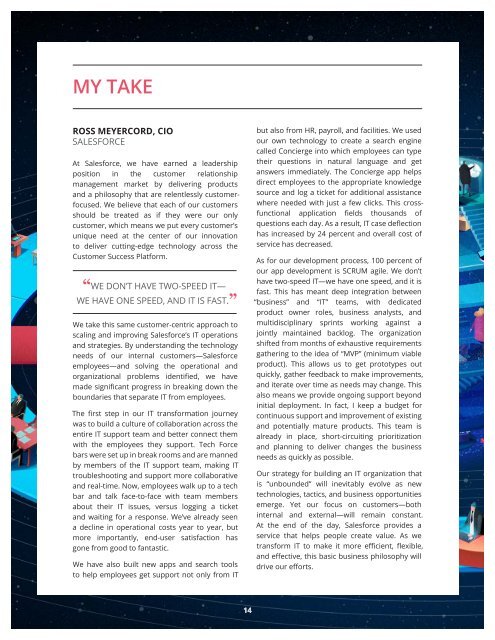Trending the trends Eight years of research
2kcf8xh
2kcf8xh
You also want an ePaper? Increase the reach of your titles
YUMPU automatically turns print PDFs into web optimized ePapers that Google loves.
MY TAKE<br />
ROSS MEYERCORD, CIO<br />
SALESFORCE<br />
At Salesforce, we have earned a leadership<br />
position in <strong>the</strong> customer relationship<br />
management market by delivering products<br />
and a philosophy that are relentlessly customerfocused.<br />
We believe that each <strong>of</strong> our customers<br />
should be treated as if <strong>the</strong>y were our only<br />
customer, which means we put every customer’s<br />
unique need at <strong>the</strong> center <strong>of</strong> our innovation<br />
to deliver cutting-edge technology across <strong>the</strong><br />
Customer Success Platform.<br />
“WE DON’T HAVE TWO-SPEED IT—<br />
WE HAVE ONE SPEED, AND IT IS FAST.”<br />
We take this same customer-centric approach to<br />
scaling and improving Salesforce’s IT operations<br />
and strategies. By understanding <strong>the</strong> technology<br />
needs <strong>of</strong> our internal customers—Salesforce<br />
employees—and solving <strong>the</strong> operational and<br />
organizational problems identified, we have<br />
made significant progress in breaking down <strong>the</strong><br />
boundaries that separate IT from employees.<br />
The first step in our IT transformation journey<br />
was to build a culture <strong>of</strong> collaboration across <strong>the</strong><br />
entire IT support team and better connect <strong>the</strong>m<br />
with <strong>the</strong> employees <strong>the</strong>y support. Tech Force<br />
bars were set up in break rooms and are manned<br />
by members <strong>of</strong> <strong>the</strong> IT support team, making IT<br />
troubleshooting and support more collaborative<br />
and real-time. Now, employees walk up to a tech<br />
bar and talk face-to-face with team members<br />
about <strong>the</strong>ir IT issues, versus logging a ticket<br />
and waiting for a response. We’ve already seen<br />
a decline in operational costs year to year, but<br />
more importantly, end-user satisfaction has<br />
gone from good to fantastic.<br />
We have also built new apps and search tools<br />
to help employees get support not only from IT<br />
but also from HR, payroll, and facilities. We used<br />
our own technology to create a search engine<br />
called Concierge into which employees can type<br />
<strong>the</strong>ir questions in natural language and get<br />
answers immediately. The Concierge app helps<br />
direct employees to <strong>the</strong> appropriate knowledge<br />
source and log a ticket for additional assistance<br />
where needed with just a few clicks. This crossfunctional<br />
application fields thousands <strong>of</strong><br />
questions each day. As a result, IT case deflection<br />
has increased by 24 percent and overall cost <strong>of</strong><br />
service has decreased.<br />
As for our development process, 100 percent <strong>of</strong><br />
our app development is SCRUM agile. We don’t<br />
have two-speed IT—we have one speed, and it is<br />
fast. This has meant deep integration between<br />
“business” and “IT” teams, with dedicated<br />
product owner roles, business analysts, and<br />
multidisciplinary sprints working against a<br />
jointly maintained backlog. The organization<br />
shifted from months <strong>of</strong> exhaustive requirements<br />
ga<strong>the</strong>ring to <strong>the</strong> idea <strong>of</strong> “MVP” (minimum viable<br />
product). This allows us to get prototypes out<br />
quickly, ga<strong>the</strong>r feedback to make improvements,<br />
and iterate over time as needs may change. This<br />
also means we provide ongoing support beyond<br />
initial deployment. In fact, I keep a budget for<br />
continuous support and improvement <strong>of</strong> existing<br />
and potentially mature products. This team is<br />
already in place, short-circuiting prioritization<br />
and planning to deliver changes <strong>the</strong> business<br />
needs as quickly as possible.<br />
Our strategy for building an IT organization that<br />
is “unbounded” will inevitably evolve as new<br />
technologies, tactics, and business opportunities<br />
emerge. Yet our focus on customers—both<br />
internal and external—will remain constant.<br />
At <strong>the</strong> end <strong>of</strong> <strong>the</strong> day, Salesforce provides a<br />
service that helps people create value. As we<br />
transform IT to make it more efficient, flexible,<br />
and effective, this basic business philosophy will<br />
drive our efforts.<br />
14


